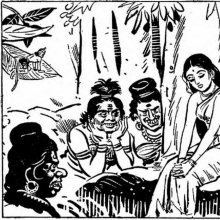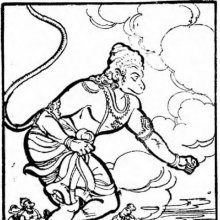Signet: 1 definition
Introduction:
Signet means something in Hinduism, Sanskrit. If you want to know the exact meaning, history, etymology or English translation of this term then check out the descriptions on this page. Add your comment or reference to a book if you want to contribute to this summary article.
Images (photo gallery)
In Hinduism
Natyashastra (theatrics and dramaturgy)
Source: Shodhganga: Elements of Art and Architecture in the Trtiyakhanda of the Visnudharmottarapurana (natya)(The holding of a) Signet or a Seal is associated with Mukula-hasta: one of the twenty-two Single-hand Gestures (in Indian Dramas) (known as asaṃyuktahastas), according to the Viṣṇudharmottarapurāṇa, an ancient Sanskrit text which (being encyclopedic in nature) deals with a variety of cultural topics such as arts, architecture, music, grammar and astronomy.—The Viṣṇudharmottarapurāṇa suggests that the tips of all fingers of the hand should be joined together to make this posture. When the tips of all fingers are joined together, it makes a shape of a blooming bud. [...] In the Abhinayadarpaṇa, the mukula-hasta posture is suggested to be used to denote flowers like water lily and the flower of kadalī i.e., banana. It says that, the holding of five arrows by Kāmadeva and a signet or a seal are also identified through this hand posture. The action of eating is also shown with this hand posture.

Natyashastra (नाट्यशास्त्र, nāṭyaśāstra) refers to both the ancient Indian tradition (shastra) of performing arts, (natya—theatrics, drama, dance, music), as well as the name of a Sanskrit work dealing with these subjects. It also teaches the rules for composing Dramatic plays (nataka), construction and performance of Theater, and Poetic works (kavya).
See also (Relevant definitions)
Full-text (+34): Rajamudra, Pratyayakarini, Mudra, Muddika, Mudrapacara, Angulimudda, Mudrika, Amgulimudrike, Mortabba, Ilaccinai, Shikhasara, Shikhamoharu, Mudradhikara, Mudradhikari, Mudreyole, Mudrakara, Shikkenisa, Cilmotiram, Mudradharaka, Namamotiram.
Relevant text
Search found 29 books and stories containing Signet; (plurals include: Signets). You can also click to the full overview containing English textual excerpts. Below are direct links for the most relevant articles:
Mudrarakshasa (literary study) (by Antara Chakravarty)
3. The title of the Play < [Chapter 1 - Introduction]
2. About the Drama < [Chapter 1 - Introduction]
3. Delineation of Rasa in the Mudrārākṣasa (Introduction) < [Chapter 2 - Delineation of Rasa in Mudrārākṣasa]
Puranic encyclopaedia (by Vettam Mani)
The Jataka tales [English], Volume 1-6 (by Robert Chalmers)
Jataka 7: Kaṭṭhahāri-jātaka < [Book I - Ekanipāta]
Jataka 479: Kāliṅga-Bodhi-jātaka < [Volume 4]
Jataka 4: Cullaka-Seṭṭhi-jātaka < [Book I - Ekanipāta]
Kathasaritsagara (the Ocean of Story) (by Somadeva)
Note on thieves and the history of stealing < [Notes]
Appendix 2.3 - Poison-Damsels < [Appendices]
Dasarupaka (critical study) (by Anuru Ranjan Mishra)
Part 10 - The Elements (arthaprakṛti) < [Chapter 1 - Nāṭaka (critical study)]
Part 2 - The Summary of the Līlāvatīvīthī < [Chapter 7 - Vīthī (critical study)]
Part 16 - Conclusion < [Chapter 1 - Nāṭaka (critical study)]
The Buddha (by Piyadassi Thera)

